matlab教程(张志涌)课后习题答案
matlab课后习题答案(附图)

matlab课后习题答案(附图)习题2.1画出下列常见曲线的图形y (1)⽴⽅抛物线3x命令:syms x y;ezplot('x.^(1/3)')(2)⾼斯曲线y=e^(-X^2);命令:clearsyms x y;ezplot('exp(-x*x)')(3)笛卡尔曲线命令:>> clear>> syms x y;>> a=1;>> ezplot(x^3+y^3-3*a*x*y)(4)蔓叶线命令:>> clear>> syms x y;>> a=1ezplot(y^2-(x^3)/(a-x))(5)摆线:()()tsin-=,=-by1命令:>> clear>> t=0:0.1:2*pi;>> x=t-sin(t);>>y=2*(1-cos(t)); >> plot(x,y)7螺旋线命令:>> clear >> t=0:0.1:2*pi; >> x=cos(t); >> y=sin(t); >> z=t;>>plot3(x,y,z)(8)阿基⽶德螺线命令:clear>> theta=0:0.1:2*pi;>> rho1=(theta);>> subplot(1,2,1),polar(theta,rho1)(9) 对数螺线命令:cleartheta=0:0.1:2*pi;rho1=exp(theta);subplot(1,2,1),polar(theta,rho1)(12)⼼形线命令:>> clear >> theta=0:0.1:2*pi; >> rho1=1+cos(theta); >> subplot(1,2,1),polar(theta,rho1)练习2.21. 求出下列极限值(1)nnn n3→命令:>>syms n>>limit((n^3+3^n)^(1/n)) ans = 3(2))121(lim n n n n ++-+∞→命令:>>syms n>>limit((n+2)^(1/2)-2*(n+1)^(1/2)+n^(1/2),n,inf) ans = 0(3)x x x 2cot lim 0→命令:syms x ;>> limit(x*cot(2*x),x,0) ans = 1/2 (4))(coslimcm xx ∞→命令:syms x m ; limit((cos(m/x))^x,x,inf) ans = 1(5))111(lim 1--→exx x命令:syms x>> limit(1/x-1/(exp(x)-1),x,1) ans =(exp(1)-2)/(exp(1)-1) (6))(2lim x x xx -+∞>> limit((x^2+x)^(1/2)-x,x,inf)ans = 1/2练习2.41. 求下列不定积分,并⽤diff 验证:(1)+x dxcos 1>>Clear >> syms x y >> y=1/(1+cos(x)); >> f=int(y,x) f =tan(1/2*x) >> y=tan(1/2*x); >> yx=diff(y ,x); >> y1=simple(yx) y1 =1/2+1/2*tan(1/2*x)^2 (2)+exdx1clear syms x yy=1/(1+exp(x));f=int(y,x) f =-log(1+exp(x))+log(exp(x)) syms x yy=-log(1+exp(x))+log(exp(x)); yx=diff(y,x); y1=simple(yx) y1 = 1/(1+exp(x)) (3)dx x x ?sin 2syms x yy=x*sin(x)^2; >> f=int(y,x) f =x*(-1/2*cos(x)*sin(x)+1/2*x)-1/4*cos(x)^2-1/4*x^2 clearsyms x y y=x*(-1/2*cos(x)*sin(x)+1/2*x)-1/4*cos(x)^2-1/4*x^2; yx=diff(y,x); >> y1=simple(yx) y1 = x*sin(x)^2 (4)xdx ?sec3syms x y y=sec(x)^3;f=int(y,x) f =1/2/cos(x)^2*sin(x)+1/2*log(sec(x)+tan(x)) clear syms x yy=1/2/cos(x)^2*sin(x)+1/2*log(sec(x)+tan(x)); yx=diff(y,x); y1=simple(yx) y1 =1/cos(x)^32. 求下列积分的数值解 1)dx x-10clearsyms xy=int(x^(-x),x,0,1) y =int(x^(-x),x = 0 .. 1) vpa(y,10) ans =1.291285997 2)xdx e x cos3202?πclearsyms xy=int(exp(2*x)*cos(x)^3,x, clear syms xy=int((1/(2*pi)^(1/2))*exp(-x^2/2),x,0,1) y =7186705221432913/36028797018963968*erf(1/2*2^(1/2))*2^(1/2)*pi^(1/0,2*pi) y =22/65*exp(pi)^4-22/65vpa(ans,10)(3)dx xe21221-π>> clear >> syms x>> y=int(1/(2*pi)^(1/2)*exp(-x^2/2),0,1); >> vpa(y,14) ans =.341344746068552(4)>> clear >> syms x>> y=int(x*log(x^4)*asin(1/x^2),1,3); Warning: Explicit integral could not be found. > In sym.int at 58 >> vpa(y,14) ans = 2.45977212823752(5) >> clear >> syms x1判断下列级数的收敛性,若收敛,求出其收敛值。
matlab课后习题答案(1-9章)
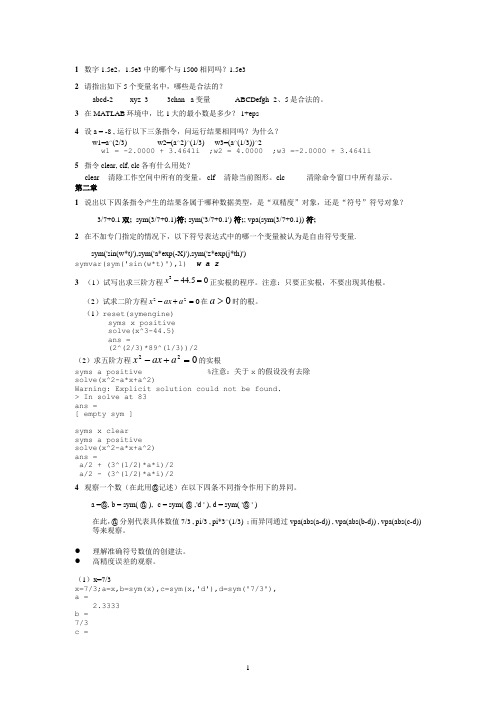
1 数字1.5e2,1.5e3 中的哪个与1500相同吗?1.5e32 请指出如下5个变量名中,哪些是合法的?abcd-2xyz_33chan a 变量ABCDefgh 2、5是合法的。
3 在MATLAB 环境中,比1大的最小数是多少? 1+eps4 设 a = -8 , 运行以下三条指令,问运行结果相同吗?为什么?w1=a^(2/3) w2=(a^2)^(1/3) w3=(a^(1/3))^2w1 = -2.0000 + 3.4641i ;w2 = 4.0000 ;w3 =-2.0000 + 3.4641i 5 指令clear, clf, clc 各有什么用处?clear 清除工作空间中所有的变量。
clf 清除当前图形。
clc 清除命令窗口中所有显示。
第二章1 说出以下四条指令产生的结果各属于哪种数据类型,是“双精度”对象,还是“符号”符号对象?3/7+0.1双; sym(3/7+0.1)符; sym('3/7+0.1') 符;; vpa(sym(3/7+0.1)) 符;2 在不加专门指定的情况下,以下符号表达式中的哪一个变量被认为是自由符号变量. sym('sin(w*t)'),sym('a*exp(-X)'),sym('z*exp(j*th)') symvar(sym('sin(w*t)'),1) w a z3 (1)试写出求三阶方程05.443=-x 正实根的程序。
注意:只要正实根,不要出现其他根。
(2)试求二阶方程022=+-a ax x 在0>a 时的根。
(1)reset(symengine)syms x positive solve(x^3-44.5) ans =(2^(2/3)*89^(1/3))/2(2)求五阶方程022=+-a ax x 的实根 syms a positive %注意:关于x 的假设没有去除 solve(x^2-a*x+a^2)Warning: Explicit solution could not be found. > In solve at 83 ans =[ empty sym ]syms x clear syms a positivesolve(x^2-a*x+a^2) ans =a/2 + (3^(1/2)*a*i)/2 a/2 - (3^(1/2)*a*i)/24 观察一个数(在此用@记述)在以下四条不同指令作用下的异同。
(完整版)MATLAB)课后实验答案[1]
![(完整版)MATLAB)课后实验答案[1]](https://img.taocdn.com/s3/m/306ff29b690203d8ce2f0066f5335a8102d266cb.png)
(完整版)MATLAB)课后实验答案[1]实验⼀ MATLAB 运算基础1. 先求下列表达式的值,然后显⽰MATLAB ⼯作空间的使⽤情况并保存全部变量。
(1) 0122sin 851z e =+(2) 21ln(2z x =,其中2120.455i x +??=?- (3) 0.30.330.3sin(0.3)ln , 3.0, 2.9,,2.9,3.022a a e e az a a --+=++=--L (4) 2242011122123t t z t t t t t ?≤=-≤,其中t =0:0.5:2.5 解:4. 完成下列操作:(1) 求[100,999]之间能被21整除的数的个数。
(2) 建⽴⼀个字符串向量,删除其中的⼤写字母。
解:(1) 结果:(2). 建⽴⼀个字符串向量例如:ch='ABC123d4e56Fg9';则要求结果是:实验⼆ MATLAB 矩阵分析与处理1. 设有分块矩阵33322322E R A O S=?,其中E 、R 、O 、S 分别为单位矩阵、随机矩阵、零矩阵和对⾓阵,试通过数值计算验证2 2E R RS A O S +??=。
解: M ⽂件如下;5. 下⾯是⼀个线性⽅程组:1231112340.951110.673450.52111456x x x ??=???(1) 求⽅程的解。
(2) 将⽅程右边向量元素b 3改为0.53再求解,并⽐较b 3的变化和解的相对变化。
(3) 计算系数矩阵A 的条件数并分析结论。
解: M ⽂件如下:123d4e56g9实验三选择结构程序设计1. 求分段函数的值。
2226035605231x x x x y x x x x x x x ?+-<≠-?=-+≤<≠≠??--?且且及其他⽤if 语句实现,分别输出x=-5.0,-3.0,1.0,2.0,2.5,3.0,5.0时的y 值。
解:M ⽂件如下:2. 输⼊⼀个百分制成绩,要求输出成绩等级A、B、C、D、E。
MATLAB教程2012a第3章习题解答张志涌(可编辑修改word版)
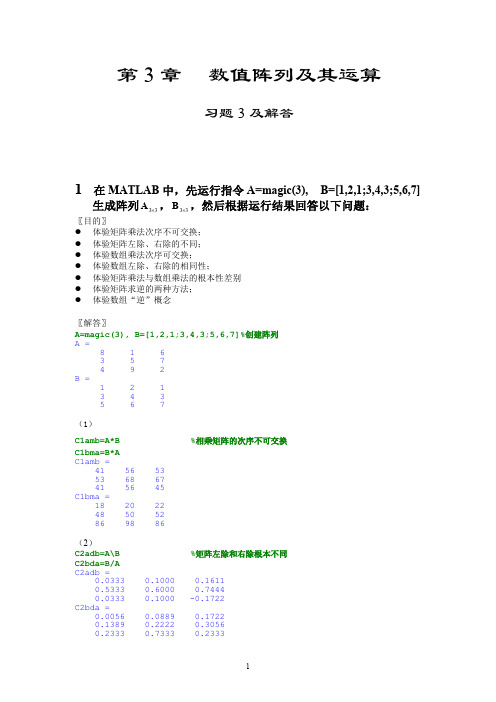
F2a=b.^A F2 =
0.99095 -0.66337 F2a =
0.5 0.125
%标量底矩阵指数的求幂 %标量底数组指数的求幂
-0.44225 0.32759
0.25 0.0625
(3)
F3a=A.^C
F3a =
1
4
3
2
%数组底数组指数的求幂
F3=A^C
%矩阵底矩阵指数的求幂运算不存在
〖解答〗
A=magic(3), B=[1,2,1;3,4,3;5,6,7]%创建阵列
A=
8
1
6
3
5
7
4
9
2
B=
1
2
1
3
4
3
5
6
7
(1)
C1amb=A*B
C1bma=B*A C1amb =
41 56 53 53 68 67 41 56 45 C1bma = 18 20 22 48 50 52 86 98 86
后根据计算结果回答以下问题:
(提示:根据对计算结果的目测回答问题)
〖目的〗 数组运算和矩阵运算的不同。 如何判断两个双精度数组是否相等。 norm 指令的应用。
〖解答〗
A=[1, 2; 3, 4],b=0.5,C=[4, 2; 1, 0.5]
A=
1
2
3
4
b=
0.5
C=
4
2
1
0.5
%创建数据
(1)
第 3 章 数值阵列及其运算
习题 3 及解答
1 在 MATLAB 中,先运行指令 A=magic(3), B=[1,2,1;3,4,3;5,6,7]
matlab第二版课后习题答案

matlab第二版课后习题答案
《MATLAB第二版课后习题答案》
MATLAB是一种强大的数学软件,被广泛应用于工程、科学和金融等领域。
《MATLAB第二版》是一本经典的教材,为了帮助学生更好地掌握MATLAB的使用,书中提供了大量的课后习题。
下面我们将为大家总结一些MATLAB第二版课后习题的答案,希望能对大家的学习有所帮助。
1. 第一章课后习题答案
第一章主要介绍了MATLAB的基本操作,包括变量的定义、矩阵的运算、函数的使用等。
在课后习题中,有一道题目是要求计算一个矩阵的逆矩阵。
答案是使用MATLAB中的inv函数,将原矩阵作为参数传入即可得到逆矩阵。
2. 第二章课后习题答案
第二章介绍了MATLAB中的绘图功能,包括二维和三维图形的绘制。
有一道课后习题是要求绘制一个正弦曲线和余弦曲线,并在同一张图上显示。
答案是使用MATLAB中的plot函数,分别绘制正弦曲线和余弦曲线,并使用legend函数添加图例。
3. 第三章课后习题答案
第三章介绍了MATLAB中的控制流程,包括if语句、for循环和while循环等。
有一道课后习题是要求编写一个程序,计算1到100之间所有偶数的和。
答案是使用for循环遍历1到100之间的所有数,判断是否为偶数并累加。
通过以上几个例子,我们可以看到MATLAB第二版课后习题的答案涵盖了各种基本和高级的操作,对于学习MATLAB是非常有帮助的。
希望大家在学习MATLAB的过程中能够多加练习,掌握更多的技巧和方法。
matlab课后习题答案(1-9章)要点

1 数字1.5e2,1.5e3 中的哪个与1500相同吗?1.5e32 请指出如下5个变量名中,哪些是合法的?abcd-2xyz_3 3chan a 变量ABCDefgh 2、5是合法的。
3 在MATLAB 环境中,比1大的最小数是多少? 1+eps4 设 a = -8 , 运行以下三条指令,问运行结果相同吗?为什么?w1=a^(2/3) w2=(a^2)^(1/3) w3=(a^(1/3))^2w1 = -2.0000 + 3.4641i ;w2 = 4.0000 ;w3 =-2.0000 + 3.4641i 5 指令clear, clf, clc 各有什么用处?clear 清除工作空间中所有的变量。
clf 清除当前图形。
clc 清除命令窗口中所有显示。
第二章1 说出以下四条指令产生的结果各属于哪种数据类型,是“双精度”对象,还是“符号”符号对象?3/7+0.1双; sym(3/7+0.1)符; sym('3/7+0.1') 符;; vpa(sym(3/7+0.1)) 符;2 在不加专门指定的情况下,以下符号表达式中的哪一个变量被认为是自由符号变量. sym('sin(w*t)'),sym('a*exp(-X)'),sym('z*exp(j*th)') symvar(sym('sin(w*t)'),1) w a z3 (1)试写出求三阶方程05.443=-x 正实根的程序。
注意:只要正实根,不要出现其他根。
(2)试求二阶方程022=+-a ax x 在0>a 时的根。
(1)reset(symengine)syms x positive solve(x^3-44.5) ans =(2^(2/3)*89^(1/3))/2(2)求五阶方程022=+-a ax x 的实根 syms a positive %注意:关于x 的假设没有去除 solve(x^2-a*x+a^2)Warning: Explicit solution could not be found. > In solve at 83 ans =[ empty sym ]syms x clear syms a positivesolve(x^2-a*x+a^2) ans =a/2 + (3^(1/2)*a*i)/2 a/2 - (3^(1/2)*a*i)/24 观察一个数(在此用@记述)在以下四条不同指令作用下的异同。
MATLAB第1-8章答案

第1章一、思考题4. (1) B=A(2:5,1:2:5)(2)A(7)=[](3) A=A+30(4)size(A)(5) t(find(t==0))=eps(6)t=reshape(x,3,4)(7)abs('matlab')(8)char(93)5. A=[97,67,34,10;-78,75,65,5;32,5,-23,-59;0,-12,54,7](1) B=A(1:3,:)C=A(:,1:2)D=A(2:4,3:4)E=B*C(2)A(find(A>=50 & A<=100))二、实验题1.x=-74/180*pi;y=-27/180*pi;sin(x*x+y*y)/sqrt(tan(abs(x+y)))+pi2.a=-3.0:0.1:3.0;exp(-0.3*a).*sin(a+0.3)3.x=[2,4;-0.45,5];log(x+sqrt(1+x.*x))/24. A=[3,54,2;34,-45,7;87,90,15];B=[1,-2,67;2,8,74;9,3,0]; (1)A*Bans =129 432 41977 -407 -1052402 591 12489A.*Bans =3 -108 13468 -360 518783 270 0(2) A^3ans =-28917 240246 -4368137883 -259101 27669171333 252504 38673A.^3ans =27 157464 839304 -91125 343658503 729000 3375(3)A/Bans =-5.8845 5.3549 -0.20286.3554 -5.6596 4.3293-6.6325 6.2078 9.0241B/Aans =30.2855 19.2643 -8.561433.4394 21.1547 -9.3974-0.7443 -0.3938 0.2830(4)[A,B]ans =3 54 2 1 -2 6734 -45 7 2 8 7487 90 15 9 3 0[A([1,3],:);B^2]ans =3 54 287 90 15600 183 -81684 282 72615 6 8255.a=1+2i;b=3+4i;c=exp(pi*i/6)c =0.8660 + 0.5000ic+a*b/(a+b)ans =1.6353 + 1.8462i第2章一、思考题3.s=0;for n=0:63s=s+2^n;enddisp(s)n=0:63;s=sum(2.^n)二、实验题1.x=input('输入一个四位整数:');y=[fix(x/1000),mod(fix(x/100),10),mod(fix(x/10),10),mod(x,10)] z=mod((y+7),10)x=z(3)*1000+z(4)*100+z(1)*10+z(2)2.gh=input('输入工号');h=input('输入工时');dj=84;if h>120gz=dj*120+1.15*dj*(h-120);elseif h<60gz=dj*h-700;elsegz=dj*h;endformat bank;display([gh,gz])3.循环结构n=input('input n:');s=0;for k=1:ns=s+1/k^2;enddisplay(sqrt(s*6))向量运算n=input('input n:');k=1:n;display(sqrt(sum(1./k.^2)*6))4.y=0;k=0;while y<3k=k+1;y=y+1/(2*k-1);enddisplay([k-1,y-1/(2*k-1)])5.x0=0;x=1;k=0;a=input('a=');b=input('b=');while abs(x-x0)>=1e-5 && k<500x0=x;x=a/(b+x0);k=k+1;enddisplay([k,x]);display([(-b+sqrt(b^2+4*a))/2,(-b-sqrt(b^2+4*a))/2]);6.y=fun(40)/(fun(30)+fun(20))(1)函数文件fun.mfunction f=fun(n)f=n+log(n^2+5);(2)函数文件fun.mfunction f=fun(n)a=1:n;f=sum(a.*(a+1));第3章一、思考题4.t=0:0.01:1.5;y=sqrt(3)/2*exp(-4*t).*sin(4*sqrt(3)*t+pi/3);5.x=-10:0.01:10;y=linspace(-6,6,size(x,2))z=x.^3+3*x.*y.^2;plot3(x,y,z)6.x=100:100:400;y=100:100:400;z=[636,697,624,478;698,712,630,478;680,674,598,412;662,626,552,334]; [X,Y]=meshgrid(x,y);mesh(X,Y,z)二、实验题1.(1)x=-10:0.01:10;plot(x,x-x.^3/3/2)(2)plot(x,exp(-x.*x/2)/2/pi)(3)x=-8:0.01:8;plot(x,sqrt((64-x.*x)/2))(4)t=0:pi/100:6*pi;plot(t.*sin(t),t.*cos(t))2. (1)x1=linspace(0,1,100);y1=2*x1-0.5;t=linspace(0,pi,100);x=sin(3*t).*cos(t);y=sin(3*t).*sin(t);plot(x1,y1,'r-',x,y,'b:');text(0.4,1,'y=2x-0.5');text(-0.4,0.5,'x=sin(3t)cos(t)');text(-0.4,0.3,'y=sin(3t)sin(t)');(2)subplot(1,2,1);scatter(x1,y1,10)title('y=2x-0.5');subplot(1,2,2);scatter(x,y,10)3.subplot(1,21);x=1:1:100; y=sin(1./x);plot(x,y)subplot(1,2,2);fplot('sin(1/x)',[1,100])4.subplot(2,2,1);bar(t,y);subplot(2,2,2);stairs(t,y);subplot(2,2,3);stem(t,y)subplot(2,2,4);semilogy(t,y);5.theta=linspace(-pi,pi,100);ro=5.*cos(theta)+4;polar(theta,ro);fi=linspace(0,2*pi,100);a=1r=a.*(1+cos(fi));polar(fi,r);6.t=0:pi/20:2*pi;x=exp(-t./20).*cos(t);y=exp(-t./20).*sin(t);z=t; plot3(x,y,z);t=0:0.01:1;x=t;y=t.^2;z=t.^3;plot3(x,y,z);7.x=-30:0.1:0;y=0:0.1:30;[x,y]=meshgrid(x,y);z=10.*sin(sqrt(x.^2+y.^2))./sqrt(1+x.^2+y.^2); meshc(x,y,z);8.x=linspace(-3,3,100);y=linspace(-3,3,100);[x y]=meshgrid(x,y);fxy=-5./(1+x.^2+y.^2);i=find(abs(x)<=0.8 & abs(y)<=0.5);fxy(i)=NaN;surf(x,y,fxy)9.u=linspace(1,10,100);v=linspace(-pi,pi,100);[u,v]=meshgrid(u,v);x=3.*u.*sin(v);y=2.*u.*cos(v);z=4*u.^2;x=3*u.*sin(v);y=2*u.*cos(v);z=4*u.^2;surf(x,y,z);shading interp;light('position',[1,0,1]);10.t=0:pi/100:2*pi;y=sin(t);comet(t,y)第4章一、思考题5.(1)A=eye(3);(2)C=100+(200-100)*rand(5,6);(3)D=1+sqrt(0.2)*randn(1,500);(4)E=ones(size(A));(5)A=A+30*eye(size(A));(6)B=diag(diag(A))二、实验题1.P=pascal(5);H=hilb(5);Dp=det(P);Dh=det(H);Kp=cond(P);Kh=cond(H);P矩阵的性能更好,因为Kp较小2.A=[1,-1,2,3;0,9,3,3;7,-5,0,2;23,6,8,3]B=[3,pi/2,45;32,-76,sqrt(37);5,72,4.5e-4;exp(2),0,97]A1=diag(A);B1=diag(B);A2=triu(A);B2=triu(B);A3=tril(A);B3=tril(B);rA=rank(A);rB=rank(B);nA=norm(A);nb=norm(B);cA=cond(A);cB=cond(B);3.A=[31,1,0;-4,-1,0;4,-8,-2];[V,D]=eig(A);4.A=diag([-1,-1,-1,-1],-1)+diag([-1,-1,-1,-1],1)+diag([2,2,2,2,2]) b=[1,0,0,0,0]';x1=inv(A)*b;x2=A\b;[L,U]=lu(A);x3=U\(L\b);[Q,R]=qr(a);[Q,R]=qr(A);x4=R\(Q\b)R=chol(A);x5=R\(R'\b)5.B=sparse(A);x1=inv(B)*b;x2=B\b;[L,U]=lu(B);x3=U\(L\b);第5章一、思考题3.A=randn(10,5);mean(A)std(A)max(max(A))min(min(A))sum(A,2)sum(sum(A))sort(A,1)sort(A,2,'descend')二、实验题1.A=rand(1,30000);mean(A)std(A)max(A)min(A)size(find(A>0.5))/size(A)2.h=[466,715,950,1422,1635];w=[7.04,4.28,3.40,2.52,2.13];hh=[500,900,1500];ww=interp1(h,w,hh,'spline')3.x=linspace(1,10,50);y=log(x);f=polyfit(x,y,5);yy=polyval(f,x);plot(x,y,'r-',x,yy,'g.')4.N=64; % 采样点数T=5; % 采样时间终点t=linspace(0,T,N); % 给出N个采样时间ti(I=1:N) x=3*exp(-t); % 求各采样点样本值xdt=t(2)-t(1); % 采样周期f=1/dt; % 采样频率(Hz)X=fft(x); % 计算x的快速傅立叶变换XF=X(1:N/2+1); % F(k)=X(k)(k=1:N/2+1) f=f*(0:N/2)/N; % 使频率轴f从零开始plot(f,abs(F),'-*') % 绘制振幅-频率图xlabel('Frequency');ylabel('|F(k)|')5.(1)p1=[1 2 0 0 7];p2=[1 -2];p3=[1 0 0 5 1];p12=conv(p1,p2);p=p12+[zeros(1,size(p12,2)-size(p3,2)),p3];roots(p)(2)A=[-1,4,3;2,1,5;0,5,6];Px=polyval(p,A)Pxm=polyvalm(p,A)6.(1)z=fzero('3*x-sin(x)+1',0)(2)建立函数文件myfun.mfunction F=myfun(X)x=X(1);y=X(2);F(1)=x*x+y*y-9;F(2)=x+y-1;在命令窗口中输入以下命令:x=fsolve(@myfun,[3,0]',optimset('Display','off')) 第6章一、思考题2.fx=inline('1./(1+x.^2)');[I,n]=quad(fx,-100000,100000,1e-3);[I,n]=quadl(fx,-100000,100000,1e-3);x=-100000:0.01:100000;y=1./(1+x.*x);trapz(x,y);3.(1)fx=inline('-2*y+2*x*x+2*x');[t,y]=ode23(fx,[0,0.5],1)(2)fx=inline('y-exp(x)*cos(x)');[t,y]=ode23(fx,[0,3],1)二、实验题1.for x=1:3fx=[x,x^2,x^3;1,2*x,3*x;0,2,6*x];diff(fx)end2.(1)x=0:0.01:1;y=x.^10+10.^x+1./log10(x);dy=diff(y)/0.01;(2)x=0:0.01:1;y=log(1+x);dy=diff(y,2)/0.01;plot(x(1:99),dy)3.(1)fx=inline('x.^2.*sqrt(2*x.*x+3)');quad(fx,1,5)(2)fx=inline('x./sin(x).^2');quad(fx,pi/4,pi/3)(3)fx=inline('abs(cos(x+y))');dblquad(fx,0,pi,0,pi)(4)syms x y ;fx=x*y;int(int(fx,y^2,y+2),-1,2)x 的积分区间为【0,2】时fx=inline('x.*y');dblquad(fx,0,2,-1,2)4.x=0.3:0.2:1.5;y=[0.3895,0.6598,0.9147,1.1611,1.3971,1.6212,1.8325]; trapz(x,y)5.(1)yp=inline('-(1.2+sin(10*x))*y');[t,y]=ode23(yp,[0,5],1);(2)令''3,,21y x y x y x ='==,则可写出原方程的状态方程形式:123233221sin 31)1(2cos 5cos x tx x t t t x x x x x +--++='='='⎥⎥⎥⎦⎤⎢⎢⎢⎣⎡+⎥⎥⎥⎦⎤⎢⎢⎢⎣⎡⎥⎥⎥⎥⎥⎦⎤⎢⎢⎢⎢⎢⎣⎡+-+-=⎥⎥⎥⎥⎦⎤⎢⎢⎢⎢⎣⎡'''t x x x t t t x x x cos 00)1(2cos 51sin 311000103212321 建立函数文件ztfun.mfunction y=ztfun(t,x)b=[0;0;cos(t)];y=[0,1,0;0,0,1;-1/(3+sin(t)),-1,5*cos(2*t)/(t+1)^2]*x+b; 解微分方程组[t,y]=ode23(@ztfun,[0,5],[1;0;2]);6.建立函数文件ztfun.mfunction yy=ztfun(t,y)yy=[y(2)*y(3);-y(1)*y(3);-0.51*y(1)*y(2)];解微分方程组[t,y]=ode23(@ztfun,[0,5],[0;1;1])第7章一、思考题3.(1)数值积分fx=inline('exp(x).*(1+exp(x)).^2');quad(fx,0,log(2))符号积分f=sym('exp(x)*(1+exp(x))^2');v=int(f,0,log(2));eval(v)(2)略二、实验题1.A=sym('[1,2,3;x,y,z;3,2,1]')rank(A)inv(A)det(A)2.(1) y=sym('sqrt(x+sqrt(x+sqrt(x)))');y1=diff(y)y2=diff(y,'x',2)(2) syms x y;fxy=sin(x^2*y)*exp(-x^2-y);diff(diff(fxy,x),y)3.(1) syms xint(1/(1+x^4))(2) syms x tint((-2*x*x+1)/(2*x*x-3*x+1)^2,x,cos(t),exp(2*t)) 4.syms n xsymsum(1/(2*n+1)/(2*x+1)^(2*n+1),n,0,inf)symsum(1/(2*n+1)/(2*x+1)^(2*n+1),n,0,5)5.(1) syms xtaylor((exp(x)+exp(-x))/2,5,0)(2) syms a xtaylor(exp(-5*x)*sin(3*x+pi/3),5,a)6.(1)x=solve(sym('x^3+a*x+1=0'))(2) [x y]=solve(sym('sqrt(x^2+y^2)-100=0,3*x+5*y-8=0'))7. 方程转化为: π21'11't y y y y -=+=⎩⎨⎧符号解[y1,y11]=dsolve('Dy=y1,Dy1+y=1-t^2/pi','y(-2)=5,y1(-2)=5','t') 数值解编写函数文件ztfun.mfunction yy=ztfun(t,y)yy=[y(2);1-t^2/pi-y(1)];在命令窗口输入以下命令[t,y]=ode45(@ztfun,[-2,7],[-5;5]);t=linspace(-2,7,49)y2=y8.[x,y]=dsolve('Dx=3*x+4*y,Dy=-4*x+3*y','x(0)=0,y(0)=1')。
matlab课后习题答案1到6章
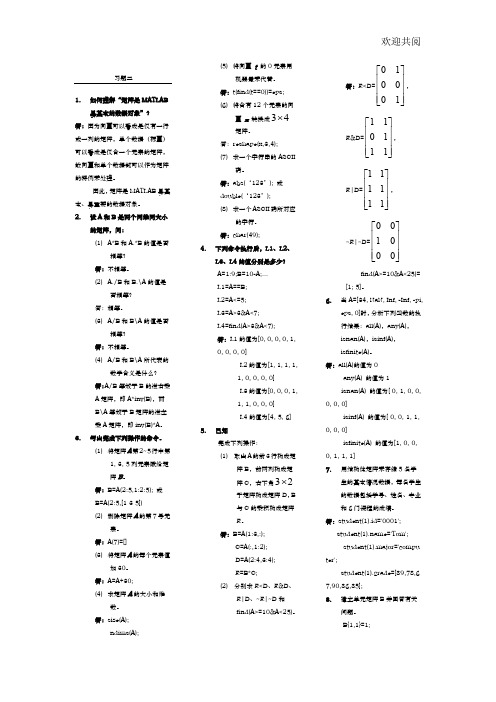
欢迎共阅习题二1.如何理解“矩阵是MATLAB 最基本的数据对象”? 答:因为向量可以看成是仅有一行或一列的矩阵,单个数据(标量)可以看成是仅含一个元素的矩阵,故向量和单个数据都可以作为矩阵的特例来处理。
(2) 删除矩阵A 的第7号元素。
答:A(7)=[](3) 将矩阵A 的每个元素值加30。
答:A=A+30;(4) 求矩阵A 的大小和维数。
答:size(A);ndims(A);(5) 将向量 t 的0元素用机器零来代替。
答:t(find(t==0))=eps; (6) 将含有12个元素的向量 x 转换成34⨯矩阵。
答:reshape(x,3,4); (7) 求一个字符串的ASCII码。
答:abs(‘123’); 或E 。
答:B=A(1:3,:); C=A(:,1:2); D=A(2:4,3:4);E=B*C;(2) 分别求E<D 、E&D 、E|D 、~E|~D 和find(A>=10&A<25)。
答:E<D=010001⎡⎤⎢⎥⎢⎥⎢⎥⎣⎦,E&D=110111⎡⎤⎢⎥⎢⎥⎢⎥⎣⎦,11⎡⎤⎢⎥答:student(1).id='0001';student(1).name='Tom'; student(1).major='computer';student(1).grade=[89,78,67,90,86,85]; 8.建立单元矩阵B 并回答有关问题。
B{1,1}=1;B{1,2}='Brenden';B{2,1}=reshape(1:9,3,3); B{2,2}={12,34,2;54,21,3;4 ,23,67};(1)size(B)和ndims(B)的值分别是多少?答:size(B) 的值为2, 2。
ndims(B) 的值为2。
(2)B(2)和B(4)的值分别是(2)建立5×6随机矩阵A,其元素为[100,200]范围内的随机整数。
matlab课后答案完整版

matlab课后答案完整版ones表⽰1矩阵zeros表⽰0矩阵ones(4)表⽰4x4的1矩阵zeros(4)表⽰4x4的0矩阵zeros(4,5)表⽰4x5的矩阵eye(10,10)表⽰10x10的单位矩阵rand(4,5)表⽰4x5的伴随矩阵det(a)表⽰计算a的⾏列式inv(a)表⽰计算a的逆矩阵Jordan(a)表⽰求a矩阵的约当标准块rank(a)表⽰求矩阵a的秩[v,d]=eig(a)对⾓矩阵b=a’表⽰求a矩阵的转置矩阵sqrt表⽰求平⽅根exp表⽰⾃然指数函数log⾃然对数函数abs绝对值第⼀章⼀、5(1)b=[97 67 34 10;-78 75 65 5;32 5 -23 -59]; >> c=[97 67;-78 75;32 5;0 -12]; >> d=[65 5;-23 -59;54 7];>> e=b*ce =5271 11574-11336 6641978 3112(2)a=50:1:100⼆、1 、x=-74;y=-27;z=(sin(x.^2+y.^2))/(sqrt(tan(abs(x+y)))+pi) z =-0.09012、a=-3.0:0.1:3.0;>> b=exp(-0.3*a).*sin(a+0.3)y =0.7218 1.0474-0.2180 1.15624、a*b表⽰a矩阵和b矩阵相乘a.*b表⽰a矩阵和b矩阵单个元素相乘A(m,n)表⽰取a矩阵第m⾏,第n列A(m,:)表⽰取a矩阵第m⾏的全部元素A(:,n)表⽰取a矩阵的第n列全部元素A./B表⽰a矩阵除以b矩阵的对应元素,B.\A等价于A./BA.^B表⽰两个矩阵对应元素进⾏乘⽅运算A.^2表⽰a中的每个元素的平⽅A^2表⽰A*A例:x=[1,2,3];y=[4,5,6];z=x.^yz=1 32 729指数可以是标量(如y=2).底数也可以是标量(如x=2)5、a=1+2i;>> b=3+4i;>> c=exp((pi*i)/6)c =0.8660 + 0.5000id=c+a*b/(a+b)d =1.6353 + 1.8462i第⼆章⼆、4、(1)y=0;k=0;>> while y<3k=k+1;>> display([k-1,y-1/(2*k-1)])ans =56.0000 2.9944第三章⼆1(1) x=0:pi/10:2*pi; >> y=x-x.^3/6; >> plot(x,y)1234567-40-35-30-25-20-15-10-505(2)x=0:pi/10:2*pi; y=(exp(-x.^2/2))/2*pi;plot(x,y)012345670.20.40.60.811.21.41.6(3)x=-8:0.01:8; y=sqrt((64-x.^2)/2);plot(x,y)-8-6-4-2024680123456(4)t=0:0.1:8*pi; >> x=t.*sin(t); >> y=t.*cos(t);-25-20-15-10-50510152025-30-20-10102030例3.4x=0:pi/100:2*pi; y1=exp(-0.5*x);y2=exp(-0.5*x).*sin(2*x); plot(x,y1,x,y2)>> title('x from 0 to 2{\pi} '); >> xlabel('variable x'); >> ylabel('variable y'); >> text(1.5,0.5,'曲线y1=e^(-0.5x)'); >> text(3,0.1,'曲线y2=cos(4{\pi}x)e^{-0.5x}'); >> legend('y1','y2')1234567-0.4-0.20.20.40.60.81x from 0 to 2πvariable xv a r i a b l e y曲线y1=e (-0.5x)曲线y2=cos(4πx)e -0.5xy1y22、(1)y1=2*x-0.5;t=linspace(0,pi,100); x=sin(3*t).*cos(t); y=sin(3*t).*sin(t);>> k=find(abs(y-x)<1e-2); >> t1=t(k) t1 =0 0.7933 1.04722.0944>> z=sin(3.*(t1)).*cos(t1) z =0 0.4841 0.0000 0.0000 -0.0000>> plot(t,x,t,y,'k:',t1,z,'bp');0.511.522.533.5-1-0.8-0.6-0.4-0.200.20.40.60.81(2)subplot(1,2,1); >> scatter(x1,y1,10); >> title('y=2x-0.5'); >> subplot(1,2,2); >> scatter(x,y,10)-1-0.8-0.6-0.4-0.200.20.40.60.81-1-0.8-0.6-0.4-0.200.20.40.63、subplot(1,2,1); x=0:0.01:pi; y=sin(1./x); plot(x,y)subplot(1,2,2);fplot('sin(1./x)',[1,100])1234-1-0.8-0.6-0.4-0.200.20.40.60.81204060801000.10.20.30.44、t=0:pi:2*pi; y=1./(1+exp(-t));subplot(2,2,1);%图形窗⼝的分割bar(t,'group'); %绘制柱形图(分组) subplot(2,2,2);barh(t,'stack');%绘制柱形图(堆积) subplot(2,2,3);loglog(t,y); %函数使⽤全对数坐标,x,y 均采⽤常⽤对数刻度 subplot(2,2,4); semilogy(t,y); %函数使⽤半对数坐标,y 轴为常⽤对数刻度,x 轴仍为线性刻度1230246802468123100.5100.710-0.01810-0.0010246810-0.310-0.210-0.15、(1)theta=linspace(-pi,pi,100); ro=5.*cos(theta)+4; polar(theta,ro); (2)x=linspace(0,2*pi,100);a=1>> r=a.*(1+cos(x)); polar(x,r);3021060240902701203001503301806、(1)t=0:pi/10:2*pi;>> x=exp((-t)/20).*cos(t); >> y=exp((-t)/20).*sin(t); >> z=t; >> plot3(x,y,z);-1-0.50.51-1-0.50.5102468(2)t=0:0.01:1; x=t;>> y=t.^2; >> z=t.^3;>> plot3(x,y,z);0.20.40.60.800.20.40.60.817、x=-30:0.1:0; >> y=0:0.1:30;>> [x,y]=meshgrid(x,y); >>z=10.*sin(sqrt(x.^2+y.^2))./sqrt(1+x.^2+y.^2);>> meshc(x,y,z);绘制曲⾯图和等⾼线-30-20-10102030-4-202468、x=linspace(-3,3,100); >> y=linspace(-3,3,100); >> [x y]=meshgrid(x,y); %可以将向量转化为矩阵 >> fxy=-5./(1+x.^2+y.^2); >> i=find(abs(x)<=0.8 & abs(y)<=0.5); >> fxy(i)=NaN; >>surf(x,y,fxy) %绘制三维曲⾯图-4-224-4-224-4-3-2-19、u=linspace(1,10,100); v=linspace(-pi,pi,100);[u v]=meshgrid(u,v); x=3.*u.*sin(v); y=2.*u.*cos(v); z=4*u.^2; surf(x,y,z); shading interp;-40-20-1010200100200300400第五章⼆1、a=rand(1,30000);mean(a) %求平均数 ans =0.5010 >>b=std(a) %求标准差 b =0.2882 >> c=max(a) c =0.9999 >> d=min(a) d =3.5706e-005size(find(a>0.5))/size(a) %求⼤于0.5的随机数个数占总数的百分⽐ans =0.50322、h=[466,715,950,1422,1635]; >> w=[7.04,4.28,3.40,2.52,2.13]; >> hh=[500,900,1500]; >> ww=interp1(h,w,hh,'spline')ww =6.4903 3.5226 2.3845 3、x=linspace(1,10,50); y=log(x);f=polyfit(x,y,5); %求曲线的拟合 >> yy=polyval(f,x); >> plot(x,y,'r-',x,yy,'g.') 123456789100.511.522.55、(1)、(2) p1=[1,2,0,7]; p2=[1,-2]; p3=[1,0,5,1]; p12=conv(p1,p2); >>p=p12+[zeros(1,size(p12,2)-size(p3,2)),p3]; >> roots(p) ans =-3.4656 0.6128 + 1.6278i 0.6128 - 1.6278i 1.2400-29 291 95 19 -3 697 -13 697 1427 >>y2=polyvalm(p,a)%以矩阵a 为⾃变量 y2 =391 2084 3273 502 2693 4207 720 3775 5892 6、(1)z=fzero('3*x-sin(x)+1',0) %求x=0时附近的根 z =-0.4903 第⼋章⼆、2t=0:pi/20:2*pi; x=sin(t); y=cos(t); x1=sin(7*t); y1=cos(7*t);h=plot(x,y,x1,y1);set(h,'marker','x','linewidth',2); set(gca,'xtick',-1:0.1:1); title('篮筐')-1-0.9-0.8-0.7-0.6-0.5-0.4-0.3-0.2-0.100.10.20.30.40.50.60.70.80.91 -1-0.8-0.6-0.4-0.200.20.40.60.81篮筐3、x=0:pi/10:5*pi;y=exp(-0.2*x).*cos(x)+2; h=plot(x,y);set(gca,'color','red','linestyle','-','linewidth',3);text(5,2.4,'y=exp(-0.2*x).*cos(x)+2');02468101214161.41.61.822.22.42.62.83y=exp(-0.2*x).*cos(x)+24、t=-pi:pi/100:pi; x=cos(t); y=sin(t); z=t;h=plot(t,x,t,y,t,z);set(h,'linestyle','-','linewidth',3);-4-3-2-101234-4-3-2-101234字符串例ch='Welcome to Beijing';subch=ch(12:18) 选12~18个字符串(空格也算)ans =WELCOME TO BEIJING >> length(k)统计⼩写字母的个数ans = 14 例:已知y=1-1/2+1/3-1/4.........-1/100求y 的值y=0; >> n=100; >> for i=1:100; y=y+(-1)^(i-1)/i; end>> disp(y)0.6882绘制⼆维曲线图x=0:pi/100:2*pi; >> y1=0.2*exp(-0.5*x).*cos(4*pi*x); >> y2=1.5*exp(-0.5*x).*cos(pi*x); >> plotyy(x,y1,x,y2); 7-0.20.20123456-202绘制三维图像例:x=sint+tcost y=cost-tsint z=tt=0:pi/10:10*pi; x=sin(t)+t.*cos(t); y=cos(t)-t.*sin(t); z=t; plot3(x,y,z); axis([-30 30 -30 30 0 35]); 坐标轴的最⼤值与最⼩值title('line in 3-D space'); 图形的题⽬ >> xlabel('x');ylabel('y');zlabel('z'); 标注坐标>> grid on; 加⽹格线 -30-20-10102030-20205101520253035xline in 3-D spaceyz三维例]2/,0[],,0[,cos sin 22ππ∈∈+=y x y x z [x,y]=meshgrid(0:pi/100:pi,0:pi/100:pi/2);>> z=sin(x.^2)+cos(y.^2);>> mesh(x,y,z);>> axis([0 4 0 1.8 -1.5 1.5]); 012340.511.5-1.5-1-0.500.511.5例3.16t=0:pi/20:2*pi; subplot(1,2,1);[x,y,z]=cylinder(sin(t),30);surf(x,y,z); 绘制三维曲⾯图subplot(1,2,2);>> [x,y,z]=peaks(100);>> mesh(x,y,z); 绘制三维⽹格图-11-10100.20.40.60.81-55-505-10-5510多项式求导例:f(x)=1/x^2+5 p=[1];>> q=[1,0,5];>> [p,q]=polyder(p,q)注:c=conv(a,b) 表⽰a 多项式与b 多项式乘积[p,r]=deconv(a,b) 表⽰a 多项式与b 多项式相除其中p 为商向量 r 为余数向量p=polyder(p) 表⽰求p 的导数 p=poleder(p,q) 表⽰求p 乘以q 的导数[p,q]=poleder(p,q) 表⽰p 除以q 的导数多项式求根例:f(x)=2x^4-12x^3+3x^2+5 p=[2,-12,3,0,5]; >> x=roots(p); >> p=[2,-12,3,0,5]; x=roots(p) 求⽅程f(x)=0的根 x =5.7246 0.8997 -0.3122 + 0.6229i -0.3122 - 0.6229i>> g=poly(x) 已知多项式的根求多项式 g =1.0000 -6.0000 1.5000 -0.00002.5000符号求导例7.3x=a(t-tsint)y=b(1-cost) 求y 对x 的⼀阶导数 syms x y a b t;>> f21=a*(t-sin(t)); >> f22=b*(1-cos(t));>> diff(f22)/diff(f21) 求y 对x 的⼀阶导数ans =b*sin(t)/a/(1-cos(t))注:diff(f1,x,2) 表⽰f1对x 的⼆阶导数diff (f3,x )表⽰z 对x 的偏导 diff (f3,y )表⽰z 对y 的偏导求不定积分int(f) 求f 的不定积分 f1=int(f,a,b) 求f 在a ,b 之间的定积分eval (f1)计算积分值符号求极限例7.2 syms x h>> f=(sin(x+h)-sin(x))/h;>> limit(f,h,0) h 趋向于0ans =cos(x)例2f=sym('(1+t/x)^x');limit(f,inf) f趋向于⽆穷ans =exp(t)例3f=sym('x*(sqrt(x^2+1)-x)');limit(f,sym('x'),inf,'left') x 趋向于正⽆穷ans =1/2⼤⼩写ch='Welcome to Beijing';subch=ch(12:18)subch =Beijing>> k=find(ch>='A'&ch<='Z'); ch(k)=ch(k)-('A'-'a');>> char(ch)ans =welcome to beijing>> length(k)ans =2。
matlab教程习题及答案

第1章MATLAB概论1.1与其他计算机语言相比较,MA TLAB语言突出的特点是什么?MA TLAB具有功能强大、使用方便、输入简捷、库函数丰富、开放性强等特点。
1.2 MA TLAB系统由那些部分组成?MA TLAB系统主要由开发环境、MA TLAB数学函数库、MA TLAB语言、图形功能和应用程序接口五个部分组成。
1.3 安装MA TLAB时,在选择组件窗口中哪些部分必须勾选,没有勾选的部分以后如何补安装?在安装MA TLAB时,安装内容由选择组件窗口中个复选框是否被勾选来决定,可以根据自己的需要选择安装内容,但基本平台(即MA TLAB选项)必须安装。
第一次安装没有选择的内容在补安装时只需按照安装的过程进行,只是在选择组件时只勾选要补装的组件或工具箱即可。
1.4 MA TLAB操作桌面有几个窗口?如何使某个窗口脱离桌面成为独立窗口?又如何将脱离出去的窗口重新放置到桌面上?在MA TLAB操作桌面上有五个窗口,在每个窗口的右上角有两个小按钮,一个是关闭窗口的Close按钮,一个是可以使窗口成为独立窗口的Undock按钮,点击Undock按钮就可以使该窗口脱离桌面成为独立窗口,在独立窗口的view菜单中选择Dock ……菜单项就可以将独立的窗口重新防止的桌面上。
1.5 如何启动M文件编辑/调试器?在操作桌面上选择‚建立新文件‛或‚打开文件‛操作时,M文件编辑/调试器将被启动。
在命令窗口中键入edit命令时也可以启动M文件编辑/调试器。
1.6 存储在工作空间中的数组能编辑吗?如何操作?存储在工作空间的数组可以通过数组编辑器进行编辑:在工作空间浏览器中双击要编辑的数组名打开数组编辑器,再选中要修改的数据单元,输入修改内容即可。
1.7 命令历史窗口除了可以观察前面键入的命令外,还有什么用途?命令历史窗口除了用于查询以前键入的命令外,还可以直接执行命令历史窗口中选定的内容、将选定的内容拷贝到剪贴板中、将选定内容直接拷贝到M文件中。
MATLAB教程_R2014a_答案_全_张志涌

可以看到,除了 a4 为精确,其余均存在很小的误差。其中 a2 与 a3 的误差较小,小于 eps 精度,故可认为为精确的。
3 独立自由变量
a1=sym('sin(w*t)') ; a2=sym('a*exp(-X)' ); a3=sym('z*exp(j*th)'); symvar(a1,1) symvar(a2,1) symvar(a3,1) ans = w ans = a ans = z
13 序列卷积
syms a b n; syms k positive; xk=a.^k; hk=b.^k; kn=subs(xk,k,k-n)*subs(hk,k,n); yk=symsum(kn,n,0,k) yk = piecewise([a == b and b ~= 0, b^k*(k + 1)], [a ~= b or b == 0, (a*a^k - b*b^k)/(a - b)])
sinint(x) 2 1.5 1 0.5 0 -0.5 -1 -1.5 -2 -6 -4 -2 0 x 2 4 6
12 积分表达式
syms x; syms n positive; yn=int((sin(x)).^n,x,0,pi/2) yn3=subs(yn,n,1/3); vpa(yn3,32) yn = beta(1/2, n/2 + 1/2)/2 ans = 1.2935547796148952674767575125656
54072115771300376388410321549680270587533748496ans25916383035209734833563133680010964690086123554相同对于矩阵而言对位相乘无差异不相同点乘与矩阵乘法进行的不是同一种运算
MATLAB 课后部分答案

P77 第2章1、>> x=2;>> y=power(x,3)+(x-0.98).^2./(x+1.35).^3-5*(x+1./x)>> x=4;>> y=power(x,3)+(x-0.98).^2./(x+1.35).^3-5*(x+1./x)7、>> mat=rand(4,5);>> m=1;>> for i=1:2for j=1:5if mat(i,j)>0.3b(m)=mat(i,j);m=m+1;endendend>> b8、>> V=inv(A)>> A=rand(5,5);10、>> A=[1 4 8 13;-3 6 -5 -9;2 -7 -12 -8];B=[5 4 3 -2;6 -2 3 -8;-1 3 -9 7]; >> C=A*B??? Error using ==> mtimesInner matrix dimensions must agree.>> C=A.*BC =5 16 24 -26-18 -12 -15 72-2 -21 108 -5611、>> x=linspace(0,2*pi,125);>> y=cos((x).*(0.5+3*sin(x)./(1+x.^2)));>> plot(x,y)13、>> x=-2:0.1:2;y=-2:0.1:2;>> [X,Y]=meshgrid(x,y);>> Z=X.^2.*exp(-X.^2-Y.^2);>> mesh(Z)建立一个M函数文件mycos.m,程序如下:function y=mycos(x)clear allx=input('请输入x的值')y=1./((x-2).^2+0.1)+1./((x-3).^3+0.01)在命令窗口输入:mycosP123 第3章1、>> x=[446 714 950 1422 1634];y=[7.04 4.28 3.40 2.54 2.13];>> xi=500:500:1500;>> yi=interp1(x,y,xi,'linear')4、>> p=[3 4 7 2 9 12];>> roots(p)8、>> a=[2 4 9;4 2 4;9 4 18];>> [V,D]=eig(a) %V的列向量是相应的特征向量,对角阵D的对角元素为a的特征值10、>> p1=[-1 4 0];p2=[-1 -4 0];>> A=polyder(p1);B=polyder(p2);>> A1=roots(A);B1=roots(B);>> y=4*A1-4*B1-A1.^2-B1.^213、>> syms x y>> Ex=int(int(x.*12.*y.^2,y,0,x),x,0,1)>> Ey=int(int(y.*12.*y.^2,x,y,1),y,0,1)>> Exy=Ex.*Ey14、>> A=rand(4,4);>> [L,U]=lu(A)>> [Q,R]=qr(A)P183 第4章1、>> n=-2*pi:0.01:2*pi;>> N=12;x=cos(n*pi./6);>> X=fft(x,N)>> nx=((n>=0)&(n<=11)); hx=((n>=0)&(n<=5)); >> xn=0.8*nx;hn=hx;>> y=conv(xn,hn)4、>> n=0:11;h=0:5;>> nx=((n>=0)&(n<=11)); hx=((n>=0)&(n<=5)); >> xn=0.8*nx;hn=hx;>> M=length(xn);N=length(hn);>> L=pow2(nextpow2(M+N-1));>> Xk=fft(xn,L);Hk=fft(hn,L);>> Yk=Xk.*Hk;>> yn=ifft(Yk,L)5、>> num=[2 3 0];den=[1 0.4 1];>> [z,p,k]=tf2zp(num,den)6、>> num=[4 15.6 6 2.4 -6.4];den=[3 2.4 6.3 -11.4 6]; >> [z,p,k]=tf2zp(num,den)>> zplane(z,p)7、>> num=[18 0 0 0];den=[18 3 -4 -1];>> [r,p,k]=residuez(num,den)9、建立一个M函数文件,程序如下:clear allN=10;[z,p,k]=buttap(N);[A,B,C,D]=zp2ss(z,p,k);wc1=100;wc2=200;[At,Bt,Ct,Dt]=lp2bp(A,B,C,D,wc1,wc2);[num1,den1]=ss2tf(At,Bt,Ct,Dt);[num2,den2]=impinvar(num1,den1);dimpulse(num2,den2)10、建立一个M函数文件,程序如下:clear allwp=100*2*pi;ws=200*2*pi;Rp=2;Rs=15;Fs=500;[N,Wc]=buttord(wp,ws,Rp,Rs,'s'); %选择滤波器的最小阶数[z,p,k]=buttap(N);[B,A]=zp2tf(z,p,k);[num,den]=bilinear(B,A,Fs); %模拟滤波器的传递函数转换为数字滤波器的传递函数freqz(num,den)11、建立一个M函数文件,程序如下:clear allN=48;w=[0.35,0.65];B=fir1(N,w,'bandpass'); %返回一个N阶的带通滤波器freqz(B) %绘制滤波器的频率响应曲线12、建立一个M函数文件,程序如下:clear allN=37;wc=0.3*pi;B=fir1(N,wc);freqz(B) %绘制滤波器的频率响应曲线13、建立一个M函数文件,程序如下:clear allN=55;F=[0:1/55:1];A=[ones(1,28),zeros(1,N-27)];B=fir2(N,F,A);freqz(B) %绘制滤波器的频率响应曲线15、建立一个M函数文件,程序如下:clear allwc=0.4*pi/(2*pi);N=12;[B,A]=butter(N,wc);%设计N阶截止频率为wc的Butterworth低通数字滤波器的传递函数模型m=dimpulse(B,A,101);stem(m,'.')P277 第6章2、建立一个M函数文件,程序如下:function [h,l]=huffmancode(P)if length(find(P<0))~=0,error('Not a prod.vector')endif abs(sum(P)-1)>10e-10error('Not a prod.vector')endn=length(P);for i=1:n-1for j=i:nif P(i)<=P(j)p=P(i);P(i)=P(j);P(j)=p;endendenddisp('概率分布'),PQ=P;m=zeros(n-1,n);for i=1:n-1[Q,l]=sort(Q);m(i,:)=[l(1:n-i+1),zeros(1,i-1)];Q=[Q(1)+Q(2),Q(3:n),1];endfor i=1:nc(i,:)=blanks(n*n);endc(n-1,n)='0';c(n-1,2*n)='1';for i=2:n-1c(n-i,1:n-1)=c(n-i+1,n*(find(m(n-i+1,:)==1))-(n-2):n*(find(m(n-i+1,:)==1)));c(n-1,n)='0';c(n-i,n+1:2*n-1)=c(n-i,1:n-1);c(n-i,2*n)='1';for j=1:i-1c(n-i,(j+1)*n+1:(j+2)*n)=c(n-i+1,n*(find(m(n-i+1,:)==j+1)-1)+1:n*find(m(n-i+1,:)==j+1));endendfor i=1:nh(i,1:n)=c(1,n*(find(m(1,:)==i)-1)+1:find(m(1,:)==i)*n);ll(i)=length(find(abs(h(i,:))~=32));endl=sum(P.*ll); %计算平均码长在命令窗口中输入:>> P=[0.20 0.15 0.13 0.12 0.1 0.09 0.08 0.07 0.06];>> [h,l]=huffmancode(P)3、建立一个M函数文件,程序如下:function[sqnr,a_quan,code]=u_pcm(a,n)% U_PCM 一个序列均匀的PCM编码.% n=量化级数的数目(偶数).% sqnr=输入信号量化噪声比(偶数)。
matlab课后习题答案1到6章

欢迎共阅习题二1.如何理解“矩阵是MATLAB 最基本的数据对象”? 答:因为向量可以看成是仅有一行或一列的矩阵,单个数据(标量)可以看成是仅含一个元素的矩阵,故向量和单个数据都可以作为矩阵的特例来处理。
(2) 删除矩阵A 的第7号元素。
答:A(7)=[](3) 将矩阵A 的每个元素值加30。
答:A=A+30;(4) 求矩阵A 的大小和维数。
答:size(A);ndims(A);(5) 将向量 t 的0元素用机器零来代替。
答:t(find(t==0))=eps; (6) 将含有12个元素的向量 x 转换成34⨯矩阵。
答:reshape(x,3,4); (7) 求一个字符串的ASCII码。
答:abs(‘123’); 或E 。
答:B=A(1:3,:); C=A(:,1:2); D=A(2:4,3:4);E=B*C;(2) 分别求E<D 、E&D 、E|D 、~E|~D 和find(A>=10&A<25)。
答:E<D=010001⎡⎤⎢⎥⎢⎥⎢⎥⎣⎦,E&D=110111⎡⎤⎢⎥⎢⎥⎢⎥⎣⎦,11⎡⎤⎢⎥答:student(1).id='0001';student(1).name='Tom'; student(1).major='computer';student(1).grade=[89,78,67,90,86,85]; 8.建立单元矩阵B 并回答有关问题。
B{1,1}=1;B{1,2}='Brenden';B{2,1}=reshape(1:9,3,3); B{2,2}={12,34,2;54,21,3;4 ,23,67};(1)size(B)和ndims(B)的值分别是多少?答:size(B) 的值为2, 2。
ndims(B) 的值为2。
(2)B(2)和B(4)的值分别是(2)建立5×6随机矩阵A,其元素为[100,200]范围内的随机整数。
MATLAB教程2012a第5章习题解答-张志涌

MATLAB教程2012a第5章习题解答-张志涌第5章数据和函数的可视化习题5及解答1 已知椭圆的长、短轴2,4==b a ,⽤“⼩红点线”画椭圆?==t b y ta x sin cos 。
(参见图p5-1)〖解答〗clfa=4;b=2;t=0:pi/80:2*pi; x=a*cos(t); y=b*sin(t);plot(x,y,'r.','MarkerSize',15) axis equal xlabel('x') ylabel('y') shg2 根据表达式θρcos 1-=绘制如图p5-2的⼼脏线。
(提⽰:采⽤极坐标绘线指令polar )〖解答〗clftheta=0:pi/50:2*pi; rho=1-cos(theta);h=polar(theta,rho,'-r'); %极坐标绘线指令。
h 是所画线的图柄。
set(h,'LineWidth',4) %利⽤set 设置h 图形对象的“线宽” axis square %保证坐标的圆整性 title('\rho =1-cos\theta') %采⽤特殊字符映射3 A,B,C三个城市上半年每个⽉的国民⽣产总值如见表p5.1。
试画出如图p5-3所⽰的三城市上半年每⽉⽣产总值的累计直⽅图。
〖⽬的〗●借助MATLAB的帮助系统,学习直⽅图指令polar的使⽤。
●bar指令常⽤格式之⼀:bar(x,Y,'style') 。
x是⾃变量列向量;Y是与x⾏数相同的矩阵,Y的每⼀⾏被作为“⼀组”数据;style取stacked时,同⼀组数据中每个元素对应的直⽅条被相互层叠。
●在本例中,Y中的⼀列代表⼀个城市。
绘图时,各列的颜⾊,取⾃“⾊图”;图形窗的默认⾊图是jet。
〖解答〗x=(1:6)';Y=[170,120,180,200,190,220;120,100,110,180,170,180;70,50,80,100,95,12 0]';%以下两条指令是为了让读者看清x,Y中对应数据关系⽽写的。
matlab教程_R2010a张志勇-课后答案
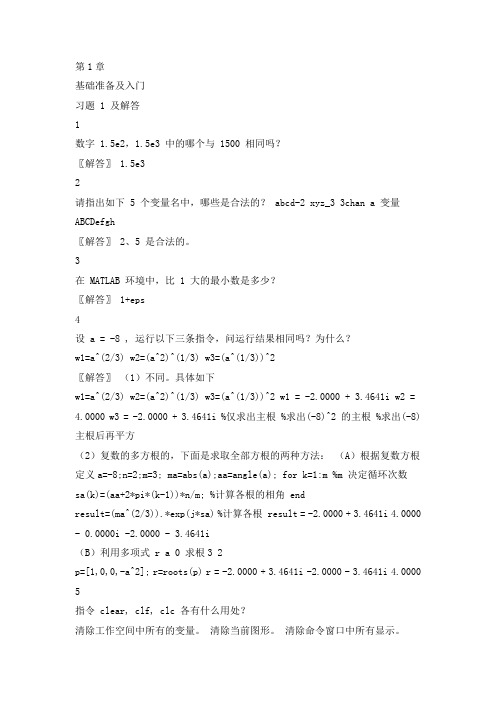
第1章基础准备及入门习题 1 及解答1数字 1.5e2,1.5e3 中的哪个与 1500 相同吗?〖解答〗 1.5e32请指出如下 5 个变量名中,哪些是合法的? abcd-2 xyz_3 3chan a 变量ABCDefgh〖解答〗 2、5 是合法的。
3在 MATLAB 环境中,比 1 大的最小数是多少?〖解答〗 1+eps4设 a = -8 , 运行以下三条指令,问运行结果相同吗?为什么?w1=a^(2/3) w2=(a^2)^(1/3) w3=(a^(1/3))^2〖解答〗(1)不同。
具体如下w1=a^(2/3) w2=(a^2)^(1/3) w3=(a^(1/3))^2 w1 = -2.0000 + 3.4641i w2 = 4.0000 w3 = -2.0000 + 3.4641i %仅求出主根 %求出(-8)^2 的主根 %求出(-8)主根后再平方(2)复数的多方根的,下面是求取全部方根的两种方法:(A)根据复数方根定义a=-8;n=2;m=3; ma=abs(a);aa=angle(a); for k=1:m %m 决定循环次数sa(k)=(aa+2*pi*(k-1))*n/m; %计算各根的相角 endresult=(ma^(2/3)).*exp(j*sa) %计算各根 result = -2.0000 + 3.4641i 4.0000 - 0.0000i -2.0000 - 3.4641i(B)利用多项式 r a 0 求根3 2p=[1,0,0,-a^2]; r=roots(p) r = -2.0000 + 3.4641i -2.0000 - 3.4641i 4.0000 5指令 clear, clf, clc 各有什么用处?清除工作空间中所有的变量。
清除当前图形。
清除命令窗口中所有显示。
〖解答〗 clear clfclc6以下两种说法对吗?(1)“MATLAB 进行数值的表达精度与其指令窗中的数据显示精度相同。
北航 MATLAB教程答案(张志涌)
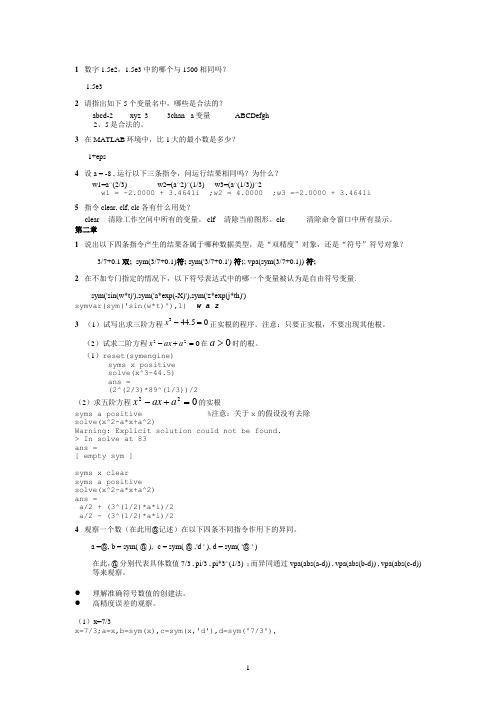
1 数字1.5e2,1.5e3 中的哪个与1500相同吗?1.5e32 请指出如下5个变量名中,哪些是合法的? abcd-2 xyz_3 3chan a 变量 ABCDefgh2、5是合法的。
3 在MATLAB 环境中,比1大的最小数是多少?1+eps4 设 a = -8 , 运行以下三条指令,问运行结果相同吗?为什么?w1=a^(2/3) w2=(a^2)^(1/3) w3=(a^(1/3))^2w1 = -2.0000 + 3.4641i ;w2 = 4.0000 ;w3 =-2.0000 + 3.4641i 5 指令clear, clf, clc 各有什么用处?clear 清除工作空间中所有的变量。
clf 清除当前图形。
clc 清除命令窗口中所有显示。
第二章1 说出以下四条指令产生的结果各属于哪种数据类型,是“双精度”对象,还是“符号”符号对象?3/7+0.1双; sym(3/7+0.1)符; sym('3/7+0.1') 符;; vpa(sym(3/7+0.1)) 符;2 在不加专门指定的情况下,以下符号表达式中的哪一个变量被认为是自由符号变量. sym('sin(w*t)'),sym('a*exp(-X)'),sym('z*exp(j*th)') symvar(sym('sin(w*t)'),1) w a z3 (1)试写出求三阶方程05.443=-x 正实根的程序。
注意:只要正实根,不要出现其他根。
(2)试求二阶方程022=+-a ax x 在0>a 时的根。
(1)reset(symengine)syms x positive solve(x^3-44.5) ans =(2^(2/3)*89^(1/3))/2(2)求五阶方程022=+-a ax x 的实根 syms a positive %注意:关于x 的假设没有去除 solve(x^2-a*x+a^2)Warning: Explicit solution could not be found. > In solve at 83 ans =[ empty sym ]syms x clear syms a positivesolve(x^2-a*x+a^2) ans =a/2 + (3^(1/2)*a*i)/2 a/2 - (3^(1/2)*a*i)/24 观察一个数(在此用@记述)在以下四条不同指令作用下的异同。
matlab课后练习习题及答案详解
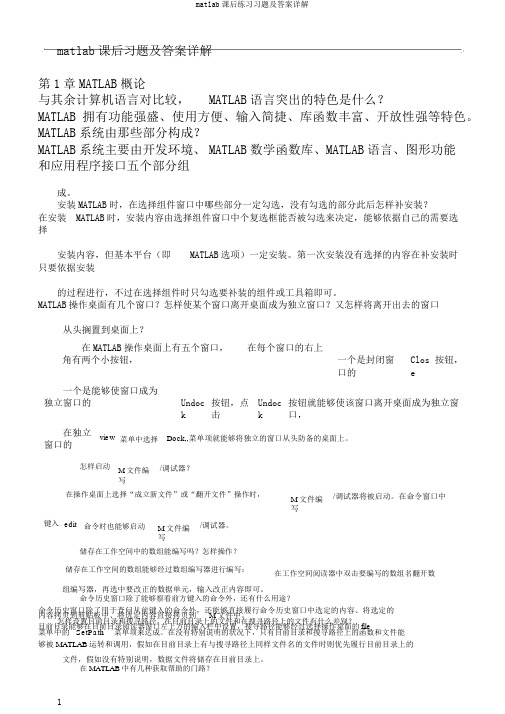
matlab课后习题及答案详解第1章MATLAB概论与其余计算机语言对比较,MATLAB语言突出的特色是什么?MATLAB拥有功能强盛、使用方便、输入简捷、库函数丰富、开放性强等特色。
MATLAB系统由那些部分构成?MATLAB系统主要由开发环境、MATLAB数学函数库、MATLAB语言、图形功能和应用程序接口五个部分组成。
安装MATLAB时,在选择组件窗口中哪些部分一定勾选,没有勾选的部分此后怎样补安装?在安装MATLAB时,安装内容由选择组件窗口中个复选框能否被勾选来决定,能够依据自己的需要选择安装内容,但基本平台(即MATLAB选项)一定安装。
第一次安装没有选择的内容在补安装时只要依据安装的过程进行,不过在选择组件时只勾选要补装的组件或工具箱即可。
MATLAB操作桌面有几个窗口?怎样使某个窗口离开桌面成为独立窗口?又怎样将离开出去的窗口从头搁置到桌面上?在MATLAB操作桌面上有五个窗口,在每个窗口的右上角有两个小按钮,一个是封闭窗口的Close按钮,一个是能够使窗口成为独立窗口的Undock 按钮,点击Undock按钮就能够使该窗口离开桌面成为独立窗口,在独立窗口的view菜单中选择Dock,,菜单项就能够将独立的窗口从头防备的桌面上。
怎样启动M文件编写/调试器?在操作桌面上选择“成立新文件”或“翻开文件”操作时,M文件编写/调试器将被启动。
在命令窗口中键入edit命令时也能够启动M文件编写/调试器。
储存在工作空间中的数组能编写吗?怎样操作?储存在工作空间的数组能够经过数组编写器进行编写:在工作空间阅读器中双击要编写的数组名翻开数组编写器,再选中要改正的数据单元,输入改正内容即可。
命令历史窗口除了能够察看前方键入的命令外,还有什么用途?命令历史窗口除了用于查问从前键入的命令外,还能够直接履行命令历史窗口中选定的内容、将选定的内容拷贝到剪贴板中、将选定内容直接拷贝到M文件中。
怎样设置目前目录和搜寻路径,在目前目录上的文件和在搜寻路径上的文件有什么差别?目前目录能够在目前目录阅读器窗口左上方的输入栏中设置,搜寻路径能够经过选择操作桌面的file菜单中的SetPath菜单项来达成。
MATLAB教程2012a第6章习题解答-张志涌
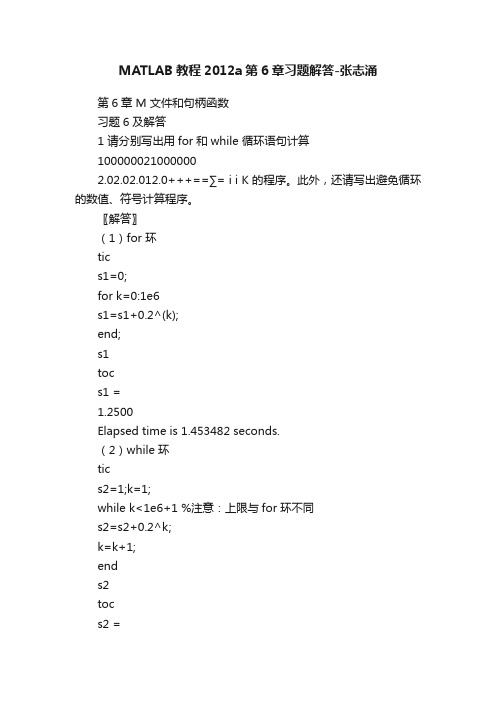
MATLAB教程2012a第6章习题解答-张志涌第6章 M 文件和句柄函数习题6及解答1 请分别写出用for 和while 循环语句计算1000000210000002.02.02.012.0+++==∑= i i K 的程序。
此外,还请写出避免循环的数值、符号计算程序。
〖解答〗(1)for 环tics1=0;for k=0:1e6s1=s1+0.2^(k);end;s1tocs1 =1.2500Elapsed time is 1.453482 seconds.(2)while 环tics2=1;k=1;while k<1e6+1 %注意:上限与for 环不同s2=s2+0.2^k;k=k+1;ends2tocs2 =1.2500Elapsed time is 2.716870 seconds.(3)数值求和指令tics3=sum(0.2.^(0:1e6))tocs3 =1.2500Elapsed time is 0.626723 seconds.(4)符号求和指令ticsyms k;s4=vpa(symsum(0.2^k,0,1e6))tocs4 =1.2500000000000000000000000000000Elapsed time is 4.029501 seconds.〖说明〗●使用数值求和指令和“数组运算”的计算速度最快。
●符号计算的精度最高,但速度慢。
●以上程序运行时间仅供参考。
具体时间与所用机器、那程序是否初次运行、在MATLAB指令窗还是在M-book中运行等因素有关。
2 编写一个函数M文件,它的功能:没有输入量时,画出单位圆(见图p6.2-1);输入量是大于2的自然数N时,绘制正N边形,图名应反映显示多边形的真实边数(见图p6.2-2);输入量是“非自然数”时,给出“出错提示”。
此外,函数M文件应有H1行、帮助说明和程序编写人姓名。
〖解答〗(1)函数M文件function prob_solve602(n)% prob_solve602(n) plot a circle or a polygon with n edges % prob_solve602 plot a circle% n 应为大于2的自然数% By ZZY, 2006-2-15if nargin==0t=0:pi/100:2*pi;x=exp(i*t);str='Circle';elseif (nargin~=0)&(n<=2)error('输入量应是大于2的自然数')end;if n-round(n)~=0 %检查非自然数error('输入量应是大于2的自然数')end;t=(0:n)/n*2*pi;x=exp(i*t);str=['Polygon with ', int2str(n),' edges']; % 合成字符串endplot(real(x),imag(x),'r','LineWidth',4)title(str)axis square image offshg(2)各典型运行情况prob_solve602prob_solve602(2)Error using ==> prob_solve602输入量应是大于2的自然数prob_solve602(7.3)Error using ==> prob_solve602输入量应是大于2的自然数3 用泛函指令fminbnd求|]y x--=在x=0附近的极小x|e)sin[cos(x值。
- 1、下载文档前请自行甄别文档内容的完整性,平台不提供额外的编辑、内容补充、找答案等附加服务。
- 2、"仅部分预览"的文档,不可在线预览部分如存在完整性等问题,可反馈申请退款(可完整预览的文档不适用该条件!)。
- 3、如文档侵犯您的权益,请联系客服反馈,我们会尽快为您处理(人工客服工作时间:9:00-18:30)。
t=linspace(1,10,100)
(1) y=1-exp(-0.5.*t).*cos(2.*t),plot(t,y)
(2) L=length(t)
for k=1:L, yy(k)=1-exp(-0.5*t(k))*cos(2*t(k)), end, plot(t,yy)
A1-A2
norm(A1-A2)
clear all
A=sym('[1 2;3 4]')
B1=A.^(0.5), B2=A^(0.5),
A1=simple(B1.^2)
A2=simple(B2^2)
A1-A
vpa(A1-A)
A1-A2
vpa(A1-A2)
%习题3-5
t=linspace(1,10,100)
load prob_401;
diff_y=diff(y)./diff(t);
gradient_y=gradient(y)./gradient(t);
% plot(t(1:end-1),diff_y,t,gradient_y)
figure(1)
subplot(1,2,1),plot(t,y,t(1:end-1),diff_y)
clear all, syms x n; syms n positive ; f=(sin(x))^n; yn=int(f,'x',0,pi/2), class(yn)
% y(1/3)=?
yn1=subs(yn,'n',sym(1/3)),vpa(yn1)
%或yn=limit(yn,n,1/3),vpa(yn)
syms x real
evalin(symengine,'anames(Properties)')
evalin(symengine,'getprop(x)')
%习3)
a = pi*3^(1/3) ,
b = sym( pi*3^(1/3) ),
%习题2-3
syms x a positive
x_1=solve('x^3-44.5')
syms x unreal
x_2=solve('x^2-a*x+a^2')
syms a unreal
x_2=solve('x^2-a*x+a^2')
x_3=solve('x^2-a*x-a^2')
clear,
x=-3*pi:pi/15:3*pi; y=x;
[X,Y]=meshgrid(x,y); % X=ones(size(y))*x;Y=y*ones(size(x));
warning off;
Z=sin(X).*sin(Y)./X./Y;
% (1)“非数”数目
m=sum(sum(isnan(Z))); %k=Z(isnan(Z));m=length(k)
第三章
%习题3-1
a=0:2*pi/9:2*pi
b=linspace(0,2*pi,10)
%习题3-2
rand( 'twister',0),
A=rand(3,5)
[I1,J1]=find(A>0.5)
subindex_A=sub2ind(size(A),I1,J1)
subindex_A=find(A>0.5)
grid on
S1=subs(S(1),'C3',1)
subs(S1,{x},{1.6^(1/2)})
y=double(solve(S1))
t=linspace(y(2),y(1),100)
S2=subs(S(2),'C3',1)
figure
plot(t,subs(S1,x,t)), hold on
%或yy=int(sin(x).^(1/3),x,0,pi/2) ,vpa(yy)
%习题2-23
clear, syms x y S
S = dsolve('Dy*y/5+x/4=0','x')
ezplot(subs(S(1),'C3',1),[-2,2 -2,2],1), hold on
ezplot(subs(S(2),'C3',1),[-2,2 -2,2],1)
Sa
clear
for k=10:-1:1;
A=reshape(1:10*k,k,10);
if k==1
Sa(k,:)=A;
else
Sa(k,:)=sum(A);
end
end
Sa
第四章
%习题4-1
clear all
% (2)绘图
surf(X,Y,Z); shading interp
% (3)“无裂缝”图形的全部指令:
x=-3*pi:pi/15:3*pi;y=x';
[X,Y]=meshgrid(x,y); % X=ones(size(y))*x;Y=y*ones(size(x));
X=X+(X==0)*eps;
syms k
syms x positive
fk =2/(2*k+1)*(((x-1)/(x+1))^(2*k+1))
s=symsum(fk,k,0,inf)
s1=simple(s)
%习题2-8
clear all, syms t
y=abs(sin(t))
df=diff(y),class(df)
%122_6
clear,format long, rand('twister',1),A=rand(3,3),
B=diag(diag(A)),C=A.*(~B)%或C=A-B%或C=triu(A,1)+tril(A,-1)
%习题3-3
% s=sign(randint(1,1000,[],123)-.5);
subplot(1,2,2),plot(t,y,t,gradient_y)
%上面结果不好因自变量 采样间距太小,将间距增大后结果较好
N=20
diff_y1=(diff(y(1:N:end)))./diff(t(1:N:end));
gradient_y1=(gradient(y(1:N:end)))./gradient(t(1:N:end));
G =
piecewise([1/2 < y, y^2/4], [y <= 1/2, y])
%习题2-1
class(vpa(sym(3/7+0.1),4))
%习题2-2
findsym(sym('sin(w*t)'),1)
findsym(sym('a*exp(-X)'),1)
findsym(sym('z*exp(j*th)'),1)
% plot(t(1:end-1),diff_y,t,gradient_y)
%(1)
L=length(t)
for k=1:L
yy(k)=1-exp(-0.5*t(k))*cos(2*t(k))
end
figure(1),plot(t,yy)
%(2)
y=1-exp(-0.5.*t).*cos(2.*t),
figure(2),plot(t,y)
figure(3),subplot(1,2,1),plot(t,y)
a=det(A)
B=inv(A)
C=subexpr(B)
[RS,w]=subexpr(B,'w')
%习题2-6
syms k
syms a positive
% fk =a^k * heaviside(k)
fk =a^k
s=symsum(fk,k,0,inf)
%习题2-7
clear all
c = sym( pi*3^(1/3),'d'),
d = sym( 'pi*3^(1/3) ' )
vpa(abs(a-d)) , vpa(abs(b-d)) , vpa(abs(c-d))
%习题2-5
syms a11 a12 a13 a21 a22 a23 a31 a32 a33
A = [a11 a12 a13;a21 a22 a23;a31 a32 a33]
ezplot(subs(y^2-(S(1))^2, 'C3', 1),[-2,2 -2,2],2) %用椭圆方程绘图不产生间隙
colormap([0 0 1]) %用ezplot(fun)绘图时,如果fun中只有一个参数,绘图的颜色是蓝色;如果fun中有两个参数,绘图的颜色是绿色,此指令设置图形颜色为蓝。
plot(t,subs(S2,x,t))
axis([-2,2 -2,2])
%习题2-24
x=dsolve('Dx=a*t^2+b*t','x(0)=2','t')
%习题2-25
[f,g]=dsolve('Df=3*f+4*g','Dg=-4*f+3*g','f(0)=0','g(0)=1','x')
